The siege
On 10 November, Créquy began shelling the suburb of Neuburg with artillery. At the same time Meinhardt Schomberg attacked the Freiburg Charterhouse towards the Schlossberg. During the night of 10/11 November, Colonel Kaunitz made a sally to disrupt the French in digging the trenches. On 11 November, Freiburg experienced a heavy cannonade, although the damage was limited. Kaunitz made another sortie to break up the enclosure and send messengers to the Duke of Lorraine. After the French artillery under the Marquis de Freselières had shot a breach of more than 30 meters wide in the city wall of Neuburg on 12 November, Créquy called on Freiburg to surrender. City commander Schütz refused because his officers advised against it. From 12/13 November, the French pushed the trenches further and widened the breach.
At 4 PM on 14 November, Schütz gave up the suburbs, although the French had not yet begun to storm the breach in the fortifications. The French occupied the suburbs and Créquy again called for surrender. Schütz seemed completely unable to act, which is why the Austrian government asked Count Portia to take over the command, but he refused. Meanwhile, the French were able to prepare undisturbed during the night their positions for the shelling of the inner ring of Freiburg's walls .
On 15 November, the French prepared to storm the Christopher Gate. At the same time, they managed to storm the ramparts on the Schlossberg and capture the fortifications on Karlseck. This enabled them to shoot at the defenders from above, and so Créquy had cannons brought to the highest point of the Schlossberg for an even more successful bombardment of the city. Later that day, the French made a breach in the Christopher Gate and the city commander signaled to the French that he wished to enter into surrender negotiations, after which a ceasefire ensued.
Créquy insisted that the town and castle had to be handed over by 8 AM on 16 November. After dark, gun fire was heard in Freiburg from the stronghold near Emmendingen, announcing the arrival of relief troops. During the night, messengers came from Hermann of Baden-Baden, who was approaching with an Imperial corps and who promised to be at Freiburg by the evening, at the latest.
As a consequence confusion reigned in Freiburg due to the disagreement between the city councillors, the Austrian government and the officers. But the city commander, Schütz, was determined to surrender and on 16 November, before 8 AM, the document of surrender was signed. The Austrian garrison was allowed to withdraw to Rheinfelden with their arms, while the French guaranteed life and property to the citizens. Irrespective of this, imperial and French troops plundered Freiburg. The withdrawal of the imperial units began at 1 PM. The main part of the French Army only moved into the city on 17 November.
Consequences
When Charles of Lorraine heard of Freiburg's capitulation, he arranged for the arrest of the city commander, Schütz. Court-martialed in Vienna, he was acquitted, despite numerous indications that Schütz and possibly also members of the local nobility had worked into the hands of the French. Louis XIV was known for buying or blackmailing foreign princes and their officials. General Schütz's acquittal was attributed to the influence of the Freiburg-born Viennese court chancellor, Johann Paul Hocher, who was related to Schütz.
In France, the capture of Freiburg was celebrated as a great victory and a commemorative coin was minted for this event.
The French converted the city into a fortress by Vauban, for which several suburbs were demolished.
In the Peace of Nijmegen, the Habsburgs gave up Freiburg, which remained French until 1698.

Freiburg im Breisgau, usually called simply Freiburg, is an independent city in the state of Baden-Württemberg in south-western Germany. With a population of about 231,848, it is the fourth-largest city in that state after Stuttgart, Mannheim and Karlsruhe. Its built-up area has a population of about 355,000 (2021) while the greater Freiburg metropolitan area ("Einzugsgebiet") has about 660,000 (2018).

The Battle of Freiburg, fought over three days on 3, 5, and 9 August 1644, took place during the Thirty Years' War, near Freiburg im Breisgau, now in Baden-Württemberg. A French army of 16,000, led jointly by Condé and Turenne, sought to relieve the town, which had recently surrendered to a Bavarian force under Franz von Mercy. In what has been described as the bloodiest battle of the war, around half of the French soldiers engaged were killed or wounded, with the Bavarians losing up to a third of theirs. The French claimed victory since Mercy was forced to withdraw, but the result is disputed.

Ebringen (Breisgau) is a municipality in the district of Breisgau-Hochschwarzwald in Baden-Württemberg in southern Germany.

The 10th SS Panzer Division "Frundsberg" was a German Waffen-SS armoured division during World War II. The division's first battles were in Ukraine in April 1944. Afterwards, the unit was then transferred to the west, where it fought the Allies in France and at Arnhem. The division was moved to Pomerania, then fought south east of Berlin in the Lusatian area until the end of the war.
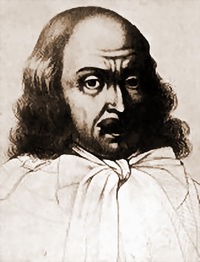
Franz Freiherr von Mercy, Lord of Mandre and Collenburg, was a German field marshal in the Thirty Years' War who fought for the Imperial side and was commander-in-chief of the Bavarian army from 1643 to 1645. In that role, he destroyed a French army at Tuttlingen (1643), stalemated another at Freiburg (1644), destroyed a third French army at Herbsthausen (1645) and was killed at the Second Battle of Nördlingen (1645).
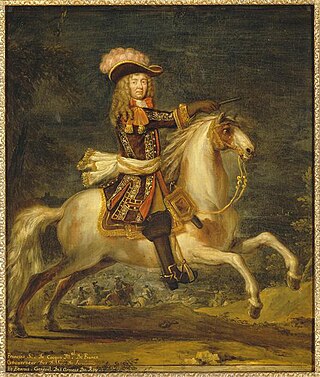
François de Blanchefort de Créquy, later Marquis de Marines, 2 October 1629 to 3 February 1687, was a 17th-century French noble and soldier, who served in the wars of Louis XIV of France.
The Battle of Konzer Brücke was fought as part of the Franco-Dutch War on 11 August 1675 and resulted in an Imperial victory.

Rötteln Castle, located above the Lörrach suburb of Haagen, lies in the extreme southwest corner of the German state of Baden-Württemberg, just 10 kilometres north-east of the Swiss City of Basel. The fortification was one of the most powerful in the southwest, and today, it is the third largest castle ruin in Baden.

The Schlossberg is a tree-covered hill of 456 metres (1,496 ft) located in the area of the city of Freiburg im Breisgau. It is directly to the east of Freiburg's Old Town and is part of the Black Forest. The main geological fault is at the western edge of the Schlossberg, towards the Upper Rhine Graben.
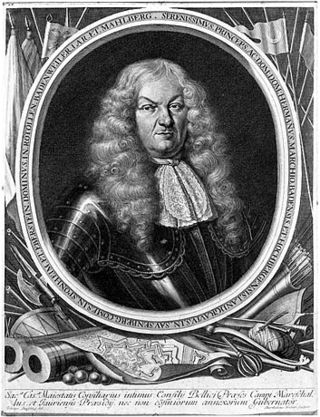
Margrave (Prince) Hermann of Baden-Baden was a general and diplomat in the imperial service. He was Field Marshal, president of the Hofkriegsrat, and the representative of the Emperor in the Perpetual Diet of Regensburg.

Freiburg Castle is a vanished castle. When it existed it was usually called the Burghaldenschloss.
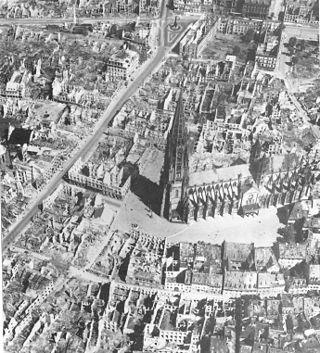
Operation Tigerfish was the military code name in World War II for the air raid on Freiburg in the evening of 27 November 1944 by the Royal Air Force with about 2,800 dead.

The Battle of Strasbourg Bridge was fought during the Swedish phase of the Thirty Years' War near the Free city of Strasbourg, in the Holy Roman Empire. Having dealt a heavy defeat on the Swedish army at the Battle of Nördlingen in September, the armies of the Emperor, Spain and the Catholic League overran much of the Swedish-held southern Germany. As a result, the Swedish commander, Rheingrave Otto Louis, decided to retreat over the Rhine with his army, using the Strasbourg bridge.

The History of Freiburg im Breisgau can be traced back 900 years. Around 100 years after Freiburg was founded in 1120 by the Zähringer, until their family died out. The unloved Counts of Freiburg followed as the town lords, who then sold it onto the Habsburgers. At the start of the 19th century, the (catholic) Austrian ownership of the town ended, when Napoleon, after having invaded the town, decreed the town and Breisgau to be a part of the Grand Duchy of Baden in 1806. Until 1918, Freiburg belonged to the Grand Duchy, until 1933 to the Weimar Republic and Gau Baden in Nazi Germany. After the Second World War, the town was the state capital of (South) Baden from 1949 until 1952. Today, Freiburg is the fourth-largest city in Baden-Württemberg.
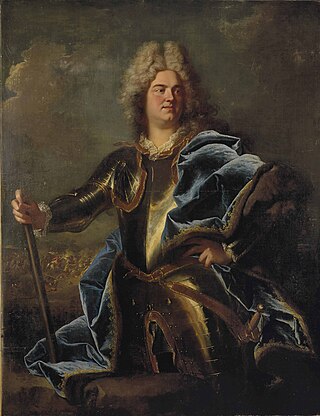
The Rhine campaign of 1713 was a successful French military campaign against the Holy Roman Empire, the sole remaining member of the once-formidable Grand Alliance which had refused to make peace with France. The campaign, which did not result in any pitched battles, ended with French forces besieging and capturing the fortified cities of Landau and Freiburg im Breisgau, which exposed the Palatinate, Württemberg and Swabia to French occupation and compelled the Emperor to sue for peace.
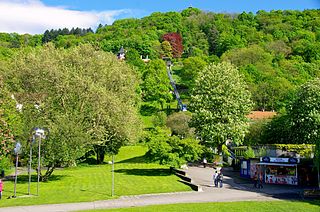
The Stadtgarten of Freiburg is a 2.6 ha park within the Neuburg district. It has an old tree grove and a large rose garden, and lies between the Leopoldring, Jackob Burckhardt, Ludwig and Mozart streets near Freiburg's city centre. It is connected to Karlsplatz via the Karlssteg footbridge, which is made from pre-stressed concrete. Since 2008 the Schlossberg Tram, an inclined elevator, leads up to Schlossberg. It replaced the Schlossberg Cable Car built in 1968.

Neuburg is a quarter of the German city Freiburg im Breisgau. The district is located directly north of the old town with its numerous sights and includes the Schlossberg which is situated east of the city's historic center. Neuburg adjoins the district Oberau on wooded Schlossberg, as well as it adjoins Herdern in the north. On its western side, the district is cut off from Stühlinger by the tracks of the Rheintalbahn running from Mannheim to Basel.
The Battle of Ortenbach, also known as the Battle of Gengenbach, took place on 23 July 1678 during the closing stages of the 1672-1678 Franco-Dutch War, in the modern German state of Baden-Württemberg. It featured a French army commanded by François de Créquy and an Imperial force under Charles V, Duke of Lorraine.

Oelenberg Abbey is a Trappist monastery located in Reiningue near Mulhouse, France. It has been an important place of worship in Alsace since the 11th century but now hosts a small community of five monks.

The siege of Philippsburg was a French siege of the Rhine fortress of Philippsburg during the Thirty Years' War. After the battle of Freiburg in early August, the French under the Duc d'Enghien refrained from attacking the city and marched north to besiege the imperial-held Philippsburg instead. The place fell after a two-week siege.


















